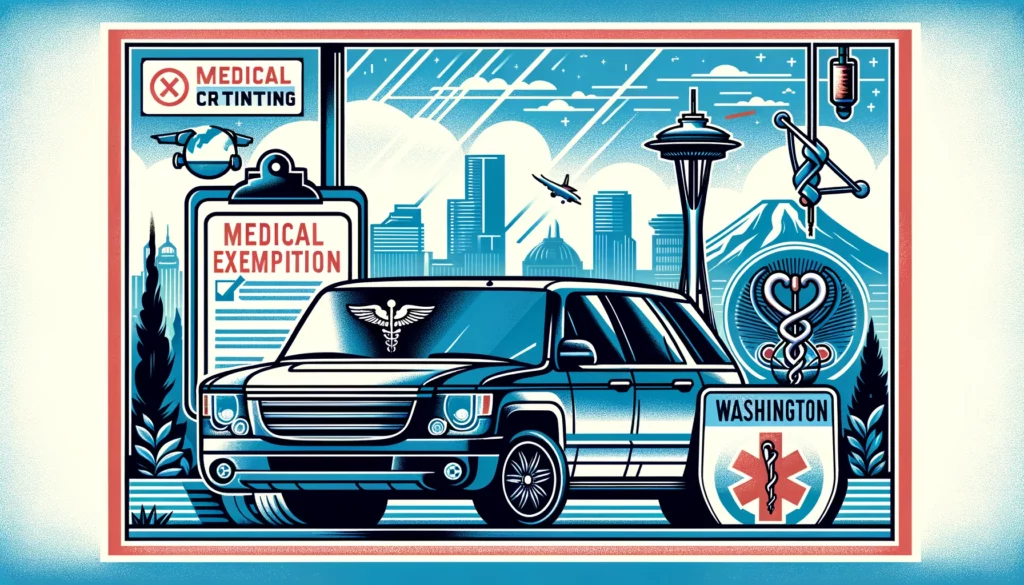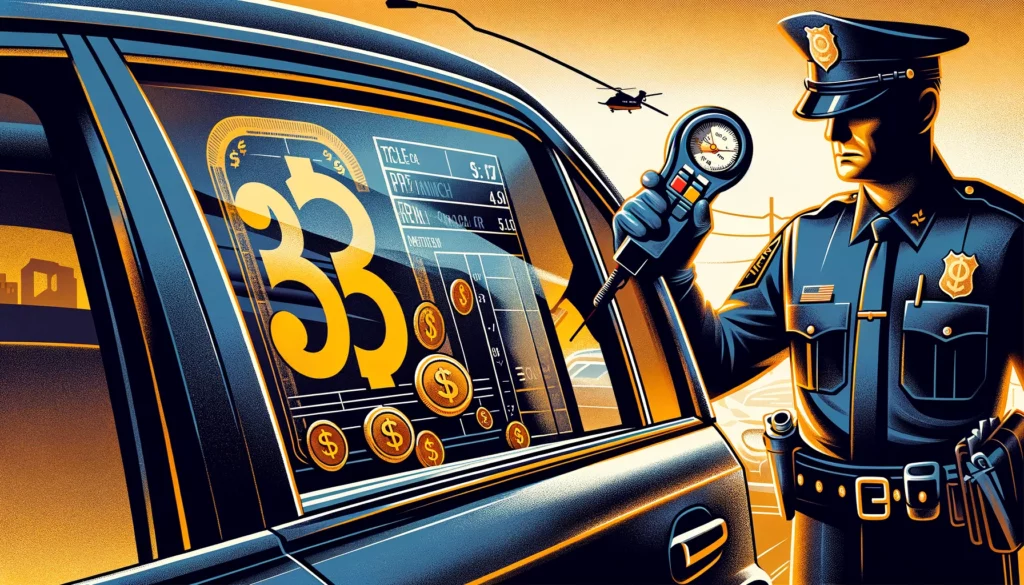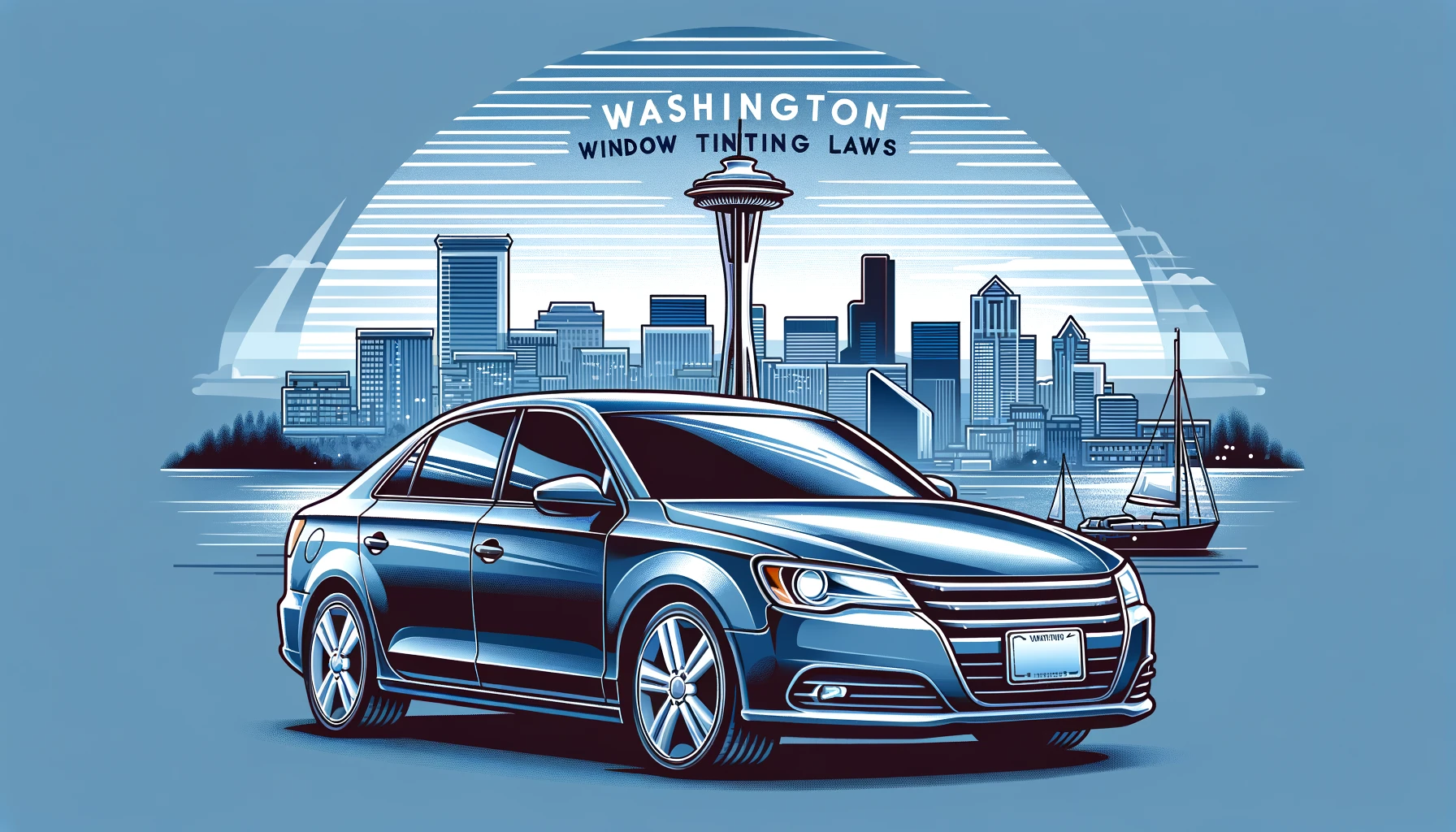Darkest legal tint for Sedans in Washington
- Windshield: Non-reflective tint is allowed on the top 6 inches of the windshield.
- Front Side windows: Must allow more than 24% of light in.
- Back Side windows: Must allow more than 24% of light in.
- Rear window: Must allow more than 24% of light in.
Darkest legal tint for SUV and Vans in Washington
- Windshield: Non-reflective tint is allowed on the top 6 inches of the windshield.
- Front Side windows: Must allow more than 24% of light in.
- Back Side windows: There are no specific darkness restrictions, meaning any darkness can be used.
- Rear window: Similarly, any darkness can be used for the rear window
Washington Tinting Regulations
Navigating the ins and outs of Washington’s tinting regulations can feel like steering through the foggy Puget Sound. The key is clarity—knowing exactly how dark you can go without getting on the wrong side of the law. Here’s your compass to guide you through the haze.
Reflecting on Reflectivity
Washington State puts a cap on how much your windows can act like a mirror. Mirror-like finishes may look cool, but they’re not road-legal here. The aim is to avoid creating hazards for other drivers, which reflective surfaces can certainly do when the sun hits just right.
Color Me Legal
Thinking about tinting your windows a snazzy color? Hold that thought. Washington puts the brakes on red, amber, and yellow tints. Stick to traditional shades to stay in the clear.
Dual Mirrors: A Must-Have
If you decide to darken your rear window, remember this: your car must be equipped with dual side mirrors. This isn’t just a fancy feature; it’s a legal requirement to compensate for the reduced visibility through that darkened glass.
Medical Exemptions for Washington Window Tint Rules

To navigate these waters, one needs a physician or optometrist to confirm that a darker tint is not a preference but a prerequisite. The documentation they provide is your passport to a safer driving experience, tailored to your health requirements.
The Certification Process: A Step-by-Step Guide
Securing this certification is akin to plotting a course: schedule an appointment, discuss your needs, secure the documentation, and keep it aboard your vehicle like a necessary piece of navigation equipment.
The Tint Test: Ensuring Compliance
With your exemption in hand, your windows will be tested to ensure they fall within the parameters of your exemption—because even with a medical need, visibility is paramount.
Renewals and Regulations: Keeping Up-to-Date
Remember, this exemption is not eternal. It must be renewed, reflecting the ever-changing conditions of health and law. Staying current is not just compliant—it’s smart.
Window Film Certificates and Stickers In Washington
Washington State doesn’t play when it comes to window tinting. Every strip of film applied to your car’s windows must come with a certificate of compliance. This isn’t just a piece of paper; it’s a testament that your chosen tint meets the light transmittance and reflectance standards set by the state. It’s like a diploma for your windows, showing they’ve passed the grade.
Sticking to the Rules: The Role of Stickers
Alongside the certificate, there’s a smaller yet equally significant player: the sticker. This little decal is placed on the driver’s side window, a subtle but clear indication that your windows are up to code. Think of it as a window’s version of a badge, a tiny sentinel confirming that you’re driving within the legal light limits.
The Process: From Film to Certification
So, how do you go about getting this all-important documentation? It starts at the installer. Reputable shops will ensure the film they use is certified and will provide you with the certificate after installation. Keep this in your glove compartment because if you ever need to prove your compliance, this certificate is your best defense.
Why Certificates and Stickers Matter
You might wonder why all the fuss about certificates and stickers. Well, they’re the proof in the pudding—or in this case, the proof on the pane. Without them, you could be subject to fines or be asked to remove your tint, which is no small task. It’s about maintaining a standard that ensures safety and uniformity on the road.
A Sticky Situation: Replacement and Repairs
Life happens—windows break, films peel, and stickers can be lost during repairs. If you find yourself in such a sticky situation, head back to your installer. They’ll sort you out with a new sticker and ensure your tint still meets the legal specifications.
Penalties or Ticket Cost for Illegal Window Tint in Washington

Rolling through Washington with a fresh tint on your windows can make you feel like the king of the road, but if that tint crosses into the realm of “too dark,” you might find yourself reigning over a kingdom of ticket costs instead.
The First Offense: A Warning to Your Wallet
In Washington, if you’re pulled over and found with window tint that’s darker than the legal limit, you’re looking at a ticket that’ll set you back $124. That’s right, one hundred and twenty-four dollars for a piece of paper that nobody wants on their dashboard.
The Repeat Offense: When the Costs Climb
But what happens if you don’t heed that first costly warning? If you’re caught again, the price jumps. A second ticket can cost upwards of $200. And if you’re really playing with fire by not removing the illegal tint, that fine will only continue to increase with each subsequent stop.
Why Such a Pricey Penalty?
Washington state takes its tint laws seriously because it’s a safety issue. Tint that’s too dark can obscure a driver’s vision, which is especially dangerous during those notorious Pacific Northwest rainy days and nights. Law enforcement carries devices to measure tint precisely because they can’t rely on a quick glance to know if you’re within the legal limits.
Conclusion
Washington’s tinting laws strike a balance between individual expression and collective road safety. They’re designed to keep everyone’s journey as safe and clear as possible. So, before you choose your shade, remember the rules of the road aren’t just guidelines; they’re the path to a safer ride for all.
Tinting your car can be a statement of style or a necessity, but staying within the boundaries of Washington’s regulations is crucial. It’s all about being as clear as you can be, both on the roads and with the law.
As you consider tinting your car, take these guidelines as your roadmap. You’ll not only personalize your ride but also maintain the collective safety on Washington’s evergreen highways.
State of Washington Info
Welcome to the State of Washington, where the evergreens touch the sky and the Pacific Ocean laps at the shores. This isn’t just a place; it’s a scene straight out of an epic tale where nature and progress dance a delicate duet.
Evergreen, Ever Growing
Washington is more than just its verdant forests. It’s a hub of innovation, the birthplace of tech giants and aeronautic pioneers. Seattle’s skyline, spiked with the iconic Space Needle, tells a story of a state that’s always reaching for the stars while keeping its feet firmly planted in the rich soil of its agricultural roots.
A Melting Pot of Culture and Cuisine
Dive into the cultural mosaic that is Washington, and you’ll taste the world in a single state. From the apple orchards of Wenatchee to the vibrant Vietnamese pho shops in the International District, it’s a place where every flavor tells a story of the people who call this state home.
The Great Outdoors: Washington’s Wild Heartbeat
Washington’s natural beauty is the stuff of legends. With places like Mount Rainier, the Hoh Rainforest, and the stunning archipelago of the San Juan Islands, it’s a playground for the adventurous soul. Hike up a volcano, sail through the Salish Sea, or simply enjoy a serene sunset on the Olympic Peninsula.
Education and Innovation: The Brains of the Operation
Education here is as refreshing as the mountain air. The University of Washington leads with research that changes the world, while tech incubators in Bellevue foster the next generation of dreamers and doers. It’s a state that educates and innovates, creating a future as bright as its bustling cities.
A Political Landscape as Diverse as Its Ecology
The political climate in Washington is as varied as its ecosystems. From the progressive streets of its larger cities to the more conservative rural areas, it’s a state that represents a full spectrum of American thought.
Economy: A Blend of Old and New
Washington’s economy is a blend of the traditional and the tech-savvy. It’s a place where aerospace, software development, and telecommunication industries coexist with forestry, fishing, and agriculture. This economic diversity is a testament to the state’s ability to grow and adapt.
Frequently Asked Questions
How reflective can my window tint be in Washington?
The window tint on the front side and back side windows must not be more than 35% reflective for both sedans and SUVs/vans.
Are there any restrictions on tint colors in Washington?
Yes, window tints in yellow, red, and amber are not allowed by Washington law.
Do I need to have dual side mirrors in Washington if my back window is tinted?
Yes, dual side mirrors are required in Washington if the back window is tinted.
Is a sticker required to identify legal tinting in Washington?
Yes, a sticker to identify legal tinting is required between the film & glass on the driver’s side window.
Does Washington allow medical exemptions for window tint?
Yes, Washington allows medical exemptions for special tint.
